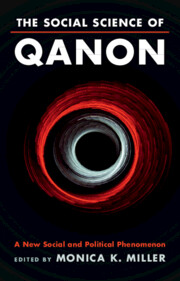Book contents
- The Social Science of QAnon
- The Social Science of QAnon
- Copyright page
- Dedication
- Contents
- Contributors
- Preface
- Part I Introduction to QAnon
- Part II Recruiting and Maintaining Followers
- Part III QAnon and Society
- Chapter 8 QAnon in the Year 2020
- Chapter 9 QAnon and the Politics of 2020
- Chapter 10 The QAnon Conspiracy Narrative
- Chapter 11 The Need to Belong
- Part IV The Role of Communication in Promoting and Limiting QAnon Support
- Part V The Future of QAnon
- Index
- References
Chapter 8 - QAnon in the Year 2020
The Bigger Social Picture
from Part III - QAnon and Society
Published online by Cambridge University Press: 14 September 2023
- The Social Science of QAnon
- The Social Science of QAnon
- Copyright page
- Dedication
- Contents
- Contributors
- Preface
- Part I Introduction to QAnon
- Part II Recruiting and Maintaining Followers
- Part III QAnon and Society
- Chapter 8 QAnon in the Year 2020
- Chapter 9 QAnon and the Politics of 2020
- Chapter 10 The QAnon Conspiracy Narrative
- Chapter 11 The Need to Belong
- Part IV The Role of Communication in Promoting and Limiting QAnon Support
- Part V The Future of QAnon
- Index
- References
Summary
QAnon started in late 2017 but gained traction and attention in 2020 amidst a chaotic social climate which is critical for understanding QAnon and its growth. This chapter presents evidence that QAnon-related traffic on social media increased during the pandemic, both domestically and globally, and offers anecdotal evidence of how QAnon’s messaging has changed as it has spread internationally, adopting nation-specific issues. Next, the chapter offers psychological explanations for these trends. Conspiracy theories flourish in times of uncertainty and group membership can provide meaningful connections that alleviate isolation. Conspiracies are more believed by people who also believe that society’s values are being threatened—an effect called system identity threat. Terror management theory suggests that reminders of death might affect the sentiment of individual people and society in general. Finally, mortality salience can promote following of religious beliefs. As a quasi-religious group, QAnon could have gained support due to mortality salience. The uncertainty and threats of 2020 might have contributed to QAnon’s popularity.
Keywords
- Type
- Chapter
- Information
- The Social Science of QAnonA New Social and Political Phenomenon, pp. 123 - 139Publisher: Cambridge University PressPrint publication year: 2023



